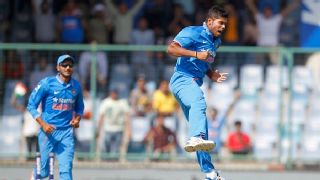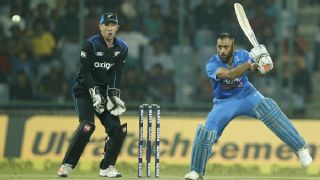|
By thrashing New Zealand in the decider, in Vizag, India thwarted criticism of their performance in the recent ODI series. They had, after all, lost two of the four matches until then. This touring New Zealand side was a weak team, and though India rested some key players, they should have done better in the ODIs - a fact, I am sure, not lost on the team management and selectors. More so given how India beat New Zealand 3-0 in the Test series. The team management and the selectors, essentially those in charge of the destiny of the Indian cricket team, must never think like the fans, who left happy seeing India win the series in grand style in Vizag. Bishan Bedi tweeted during the one-day series that the difference between the two sides was Virat Kohli. He was quite right. India in this series looked a bit like the India of the '90s, where it was basically about beating them by getting Tendulkar out early. Indian cricket has come a long way since then, and dependence on one man should not be allowed to take root. It's a sign of a weak team, which India are certainly not. MS Dhoni looked really good in Mohali when he got 80, showing that he is still a batting force in this one-day team. However, I am not a big fan of him at No. 4. People throw up his impressive numbers at four and make a case for him to bat there, but he has played at that position only a few times in his long career - not enough for those numbers to carry much weight. With the rule change in one-dayers, captains are now forced to keep five fielders inside the circle after ten overs until the 40th over. Dhoni at four will mostly bat in this phase, so he has to start his innings with five players inside the circle, all intent on saving singles. Dhoni has never been a batsman who easily taps the ball around and picks up four singles an over, like, say, Kohli does. Those are the kind of batsmen you need at that position, batsmen who are able to take singles at will, while hitting the odd boundary.  To add to Dhoni's problems, often he has to start his innings in this phase against spinners, and not seamers, against whom he gets going better, like in Mohali when he got that splendid 80. What then happens is that his strike rate for his first 30 runs is extremely low. He then backs himself to make up for the deficit later with his amazing ability to hit under pressure, but when this late surge does not materialise, he has about 40 off 80 balls. If Dhoni wants to bat at No. 4, he must be able to get his first 40 runs off at least 50 balls, so that, even if he gets out, the innings has not lost momentum. At No. 4 he also feels the added pressure of being more responsible and restrained, not looking to frequently hit the big shots to maintain a decent strike rate. For if he gets out doing so, he looks highly irresponsible - as opposed to doing the same at No. 6 or 7. I am told that under Gary Kirsten, India had a simple formula with Dhoni. He would bat when there were ten or 15 overs left in the innings, no matter how many wickets were lost at that stage. This makes a lot of sense, because batting in that situation is Dhoni's USP, really. When the field is spread out and the adrenaline of both teams is running high, that's when Captain Cool really comes into his own. Ajinkya Rahane, despite his obvious class and value for India as a Test player, is not quite the same in one-dayers, which is surprising. When Kohli bats, you can see that he has a clear plan in his head about how to approach an ODI innings, which is mostly influenced by the team's needs. It seems Rahane cannot make up his mind whether he wants to be a dasher or an anchor at the top of the order. The thing is, Rahane has the ability to hit the big shots and also to use his hands to hit through the line and get boundaries off good balls. This ability actually adds to his confusion. Rahane has the skills to be an attacking one-day player, and also to be the glue that keeps India's one-day innings together. The team management could perhaps assist him in resolving this conflict by telling him which Rahane they want in 50-overs cricket.  Manish Pandey, on the other hand, was such a let-down for me. After that hundred in Sydney earlier this year, I had my eye on him to see how he develops as a one-day middle-order batsman. I thought this series was an excellent opportunity for him to cement his place in the side. Unfortunately he seems to be from the school of batting where players bat like they need 15 runs an over when the need is for only six an over. The bulk of a one-day innings is about scoring six an over, so is it worth investing in a young batsman who takes big risks to just get those six runs an over? Unless Pandey changes his ways, I don't think he's one for the future.
Manish Pandey, on the other hand, was such a let-down for me. After that hundred in Sydney earlier this year, I had my eye on him to see how he develops as a one-day middle-order batsman. I thought this series was an excellent opportunity for him to cement his place in the side. Unfortunately he seems to be from the school of batting where players bat like they need 15 runs an over when the need is for only six an over. The bulk of a one-day innings is about scoring six an over, so is it worth investing in a young batsman who takes big risks to just get those six runs an over? Unless Pandey changes his ways, I don't think he's one for the future.
Kedar Jadhav is an interesting player, and so multifaceted. He is a prolific first-class batsman, who on average has been scoring close to 500 runs per Ranji season. In the IPL he bats at No. 6 and successfully chases 12 runs an over, and what's more, keeps wicket too. Then he comes into this India-New Zealand one-day series and shows that he can bowl some decent offspinners as well. But is he a long-term prospect for India? My worry is that his fitness, while running between the wickets with the likes of Kohli, Dhoni, Rahane and Suresh Raina, might just fall short of the high standards set by them. For once India's bowling overshadowed their batting in a one-day series at home. It was mainly the bowlers who were instrumental in India winning the series, with Hardik Pandya getting the Man-of-the-Match award in Dharamsala and Amit Mishra the Man of the Series. I wonder when the bowlers last held sway like this over an entire one-day series in India. Pandya for me was a revelation. From a bits-and-pieces cricketer he has suddenly become a seamer you can earmark to bowl ten overs. His batting is an added bonus. The brightest spot in the series, though, was Umesh Yadav, who seems to have finally found accuracy without sacrificing pace or swing. As Axar Patel started getting some runs down the order, he also got better as a bowler. Here is someone India can keep in their one-day plans - if not for anything, to push Ravindra Jadeja to be at his best. Who would have thought a review of a one-day series for India at home would end like this, where some batting issues need to be addressed, while the bowling seems fine?
|

